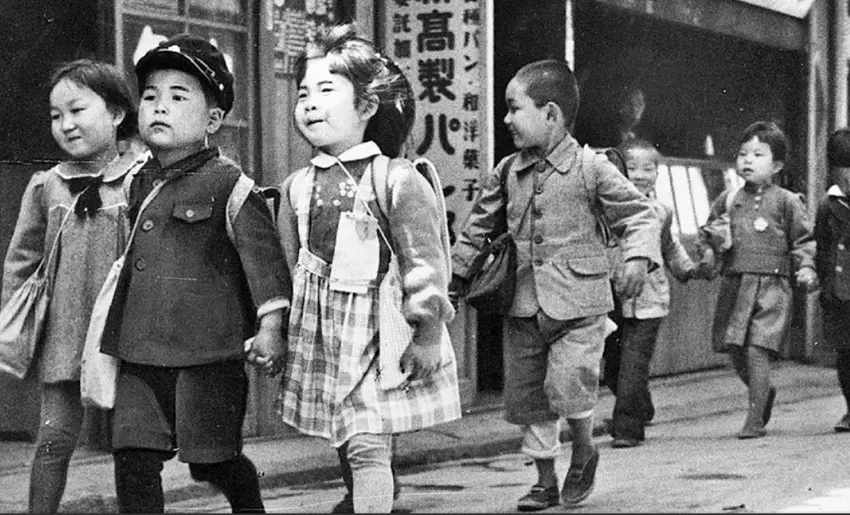Every year in April, as fluttering cherry blossom petals form a silky carpet on sun-dappled pathways, strings of children head to Japanese school entrance ceremonies, known here as nyugakushiki. Clad in variations of neatly pressed jackets, dresses and shorts, the soon-to-be elementary school students always have one item in common: oversized leather book bags.
Named randoseru, these iconic schoolbags are more than just a vehicle for stationery and textbooks; they are cultural emblems that mark an important rite of passage from toddlerhood to adolescence. Traditionally composed of firm leather, randoseru are usually red or black and feature a boxy, square silhouette — a look that has remained largely the same for more than a century. The enduring presence of randoseru stems from a tapestry of cultural and social factors, woven together by a deeply engrained national dedication to harmony.

first graders going to school in April 1950, courtesy of Mainichi Shimbun
The History and Evolution of Randoseru
Unexpected Military Roots
The origins of randoseru backpacks trace back to the Japanese military in the Edo period. As the shogunate implemented a Western military system, rucksacks from the Netherlands — known as ransel — were used to store soldiers’ belongings.
The military-grade rucksacks appeared in school settings when the prestigious Tokyo-based educational institute, Gakushuin, began shaping new ideals for students in the Meiji period. Envisioning the classroom as a place of equality, Gakushuin aimed to diminish wealth disparity among students through randoseru bags.
Under Gakushuin’s influence, affluent students were no longer permitted to commute to school in horse-drawn carriages or with servants carrying their bags. Instead, they were to transport their own equipment by foot in sturdy rucksacks. Thus, the randoseru schoolbag was born.
The New Standard
Randoseru assumed a new significance when Prince Yoshihito — the future Emperor Taisho — received one from Prime Minister Ito Hirobumi in 1887, marking the start of his formal education at Gakushin.
Initially, the leather rucksacks were considered luxury items, as they were too expensive for most families to afford. Students in rural areas often used furoshiki (wrapping cloth) bags as substitutes. As Japan experienced high economic growth from the 1950s onwards, randoseru gradually became a nationwide standard.
Over the years, the silhouette and dimensions of randoseru have remained remarkably unchanged from the royal prototype. While today’s randoseru offerings range in price, color and material, their core tenets — functionality and uniformity — remain the same.

Fostering Unity and Independence
A Voluntary Uniform
Randoseru’s more than century-long presence in Japanese culture not only demonstrates a commitment to tradition, but also a dedication to achieving harmony through sameness. The most extraordinary thing about randoseru as an essential component of Japanese school uniform history is that their adoption was never enforced in any official capacity. Everyone purchases the bags voluntarily.
According to the Ministry of Education, Culture, Sports, Science and Technology, there has never been a law decreeing its use. Sure, students are encouraged to wear backpacks for safety and convenience, but no regulations specifically state that they must carry randoseru.

The Price of Harmony
Why, then, do parents go out of their way to send their child off to school with a randoseru? Yes, they are sturdy and spacious, but they are not exactly easy to haul around. Packed with supplies, a traditional leather randoseru will weigh around 4.28 kilograms. Randoseru are also notoriously expensive, with prices averaging approximately ¥60,000.
Despite the high price tag, families are prompted to splurge on randoseru to keep up with social conventions and help their child fit in. Often, it’s customary for grandparents to bestow them upon students as they embark on the long journey of formal education. There is even a name for the search: “rankatsu,” an abbreviated form of “randoseru katsudou,” translating to “randoseru activities.”
Rankatsu pressure often stirs up discussions on income disparity. The issue has been dubbed the “randoseru gap,” which is ironic, considering the bag’s original mission was to negate classroom classism. Some local governments have implemented randoseru recycling programs to address the problem.

Path to Independence
The bag’s durability directly relates to one of the main reasons for its enduring appeal: it follows a child through all six years of primary school. This longevity is integral to randoseru’s power, and not only because of long-term cost-effectiveness — the longevity of randoseru bags also goes hand in hand with the symbolic role they have in teaching young children about independence.
A new milestone brings new responsibilities: getting to and from school alone, managing assignments and learning how to communicate and cooperate as an individual. By trusting children to care for a valuable object like a randoseru bag, parents and teachers quietly plant in them a seed of accountability that will help them flourish down the line as young adults.
More than anything, the endurance of randoseru in Japanese society forms a generational bond. Grandparents can’t help but fondly recall their own exciting first day of school, as they pore over colorful rows of neatly-stacked randoseru.
In a fleeting season of hope and renewal, we can always count on the familiar scene of bright-eyed children eagerly clutching their randoseru straps as they take the first tentative step toward their future to remind us of the heartwarming cycle of life.









